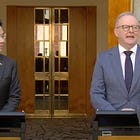Singapore Grants Australia Enhanced Military Access as Defense Partnership Deepens
This piece is freely available to read. Become a paid subscriber today and help keep Mencari News financially afloat so that we can continue to pay our writers for their insight and expertise.
Today’s Article is brought to you by Empower your podcasting vision with a suite of creative solutions at your fingertips.
Singapore will provide Australian forces with enhanced access to its air and naval facilities under a new defense cooperation agreement announced Wednesday, significantly expanding Australia’s military presence across Southeast Asia as regional security dynamics evolve.
Prime Ministers Lawrence Wong and Anthony Albanese unveiled the Enhanced Defence Cooperation Agreement during Wong’s first official visit to Canberra, marking a substantial upgrade in bilateral security relations between the longtime partners.
“We see Australia as a resident power in Asia, and your continued presence in this part of the world contributes to stability, security for all the countries in Asia,” Wong said at a joint press conference. “This will enable Australia to deploy more of its forces in our part of the world.”
The agreement builds on five decades of Singapore Armed Forces training in Australia and represents what Albanese characterized as “a logical next step” in defense cooperation that already includes ongoing joint military exercises.
Truth matters. Quality journalism costs.
Your subscription to Mencari directly funds the investigative reporting our democracy needs. For less than a coffee per week, you enable our journalists to uncover stories that powerful interests would rather keep hidden. There is no corporate influence involved. No compromises. Just honest journalism when we need it most.
Not ready to be paid subscribe, but appreciate the newsletter ? Grab us a beer or snag the exclusive ad spot at the top of next week's newsletter.
Facility Access Expansion
Under the new framework, Australian military forces will receive improved reciprocal access to Singapore’s strategic air and naval bases, though specific details of deployment scale and rotation schedules remain under development between defense officials.
“We are providing more support and enhanced access to Singapore’s air and naval bases,” Wong said. “We are working out the details of what this will entail, but clearly it will mean stronger facilitation for Australia to participate in Asia, for Australia to extend its security presence in Southeast Asia and the region more generally.”
The enhanced access provisions will enable Australia to position forces more readily throughout the region, providing operational flexibility for both routine engagement and potential crisis response scenarios.
Albanese noted that Wallaby military exercises between Australian and Singaporean forces were underway as the agreement was announced. These exercises represent one element of long-standing defense cooperation that has evolved significantly since Singapore began training operations in Australia in 1975.
Strategic Rationale
Both leaders framed the defense enhancement within broader regional security architecture, emphasizing Australia’s role as what Singapore considers a resident power contributing to regional stability.
“We believe this will be critical and important for Asia’s continued stability and security,” Wong said, linking enhanced Australian presence to broader regional security interests.
The agreement includes expanded cooperation in defense science, technology, logistics, and supply chains beyond the enhanced facility access provisions. These elements reflect both nations’ recognition that modern military cooperation extends beyond traditional deployments to encompass technological integration and supply chain resilience.
“The enhanced availability of Singapore’s ports and air access is obviously very important for Australia to be able to have that presence in South East Asia in that region,” Albanese said.
Historical Context
The defense agreement builds on a foundation established when Singapore began training its armed forces in Australia 50 years ago. Generations of Singaporean servicemembers have conducted training exercises in Australian facilities, creating institutional knowledge and personal connections that underpin current cooperation.
“Generations of our servicemen and women have benefited from your hospitality and support,” Wong said, acknowledging the historical dimension of bilateral defense ties.
Singapore has reciprocated Australian support during crisis situations, most recently deploying assistance during Queensland floods earlier in 2025. This pattern of mutual support during emergencies has characterized the defense relationship for decades.
Regional Architecture Implications
The enhanced defense cooperation occurs within a broader regional context where both nations participate in multiple multilateral security frameworks and maintain relationships across Southeast Asia and the Indo-Pacific.
Wong emphasized Singapore’s support for deeper Australian engagement throughout Southeast Asia, noting that enhanced military cooperation serves broader regional stability objectives rather than bilateral interests alone.
“Singapore will continue to support Australia’s efforts to deepen its engagement with Southeast Asia,” Wong said.
The defense agreement complements other elements of upgraded bilateral cooperation announced Wednesday, including economic resilience provisions and climate initiatives, suggesting an integrated approach to strategic partnership that encompasses multiple dimensions of national security.
Operational Considerations
While specific operational details remain under development, the enhanced access provisions will require coordination between Australian Defence Force planners and Singapore’s Ministry of Defence to establish protocols for facility usage, logistics support, and operational coordination.
The agreement’s provisions for defense science and technology cooperation suggest integration efforts may extend to equipment interoperability, joint research initiatives, and shared development programs for emerging military technologies.
Supply chain cooperation provisions reflect lessons from recent global disruptions, including pandemic-related logistics challenges, and indicate both nations view defense supply chain resilience as a critical security consideration.
Implementation Framework
Both governments tasked defense officials with developing implementation details following the ministerial-level agreement signing. The framework establishes principles and objectives while leaving specific operational parameters to be determined through ongoing consultations.
Albanese thanked Singapore for the enhanced cooperation, characterizing it as strengthening Australia’s regional presence during a period of global uncertainty and regional flux.
Multilateral Dimensions
The bilateral defense enhancement occurs as both nations participate in multiple regional security dialogues, including ASEAN-centered forums where Australia holds dialogue partner status and various multilateral exercises involving regional militaries.
Both leaders emphasized their participation in upcoming regional gatherings, including ASEAN meetings in Malaysia, APEC in South Korea, and the G20 summit, suggesting defense cooperation will be discussed within these broader multilateral contexts.
The agreement reflects both nations’ commitment to what Wong characterized as “a common strategic perspective” built on shared interests in regional stability, freedom of navigation, and rules-based security order.
Commonwealth Connections
Albanese noted both nations’ Commonwealth membership as one element of institutional connections that facilitate cooperation, though he emphasized people-to-people ties and educational exchanges as equally important foundations for partnership.
The defense agreement’s announcement during ongoing Wallaby exercises highlighted the practical, operational nature of bilateral military cooperation that extends beyond diplomatic frameworks to active joint training and capability development.
Future Trajectory
Wong characterized the enhanced defense cooperation as part of broader upgraded bilateral partnership that encompasses economic, technological, and climate dimensions alongside security cooperation.
“We have a full and ambitious agenda ahead of us,” Wong said. “Prime Minister Albanese and I have tasked our ministers to begin implementing the CSP 2.0 in earnest, and we look forward to the updates.”
The defense agreement positions both nations to adapt their security cooperation to evolving regional dynamics while maintaining commitment to multilateral frameworks and regional stability objectives that both governments identify as core national interests.
Sustaining Mencari Requires Your Support
Independent journalism costs money. Help us continue delivering in-depth investigations and unfiltered commentary on the world's real stories. Your financial contribution enables thorough investigative work and thoughtful analysis, all supported by a dedicated community committed to accuracy and transparency.
Subscribe today to unlock our full archive of investigative reporting and fearless analysis. Subscribing to independent media outlets represents more than just information consumption—it embodies a commitment to factual reporting.
As well as knowing you’re keeping Mencari (Australia) alive, you’ll also get:
Get breaking news AS IT HAPPENS - Gain instant access to our real-time coverage and analysis when major stories break, keeping you ahead of the curve
Unlock our COMPLETE content library - Enjoy unlimited access to every newsletter, podcast episode, and exclusive archive—all seamlessly available in your favorite podcast apps.
Join the conversation that matters - Be part of our vibrant community with full commenting privileges on all content, directly supporting The Evening Post (Australia)
Catch up on some of Mencari’s recent stories:

Australia, Singapore Unveil Major Strategic Partnership Upgrade Marking 60 Years of Diplomatic Ties
It only takes a minute to help us investigate fearlessly and expose lies and wrongdoing to hold power accountable. Thanks!







